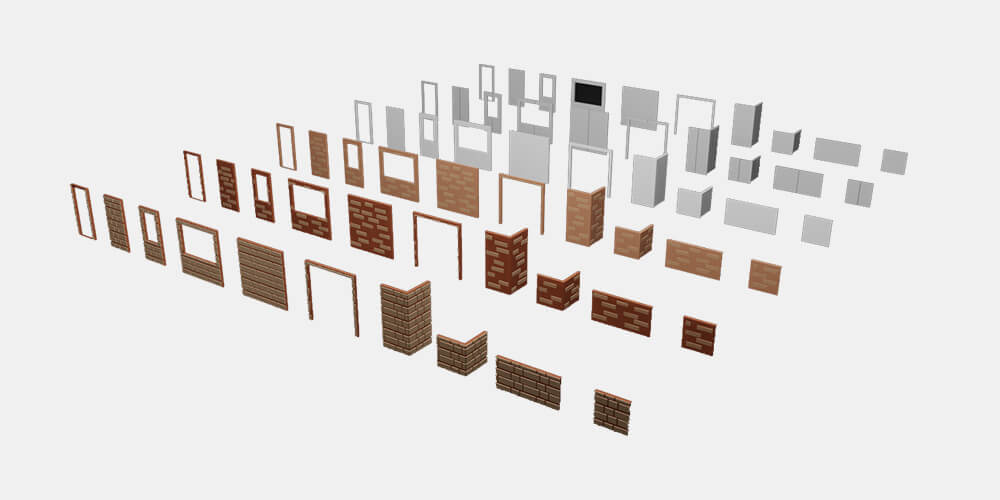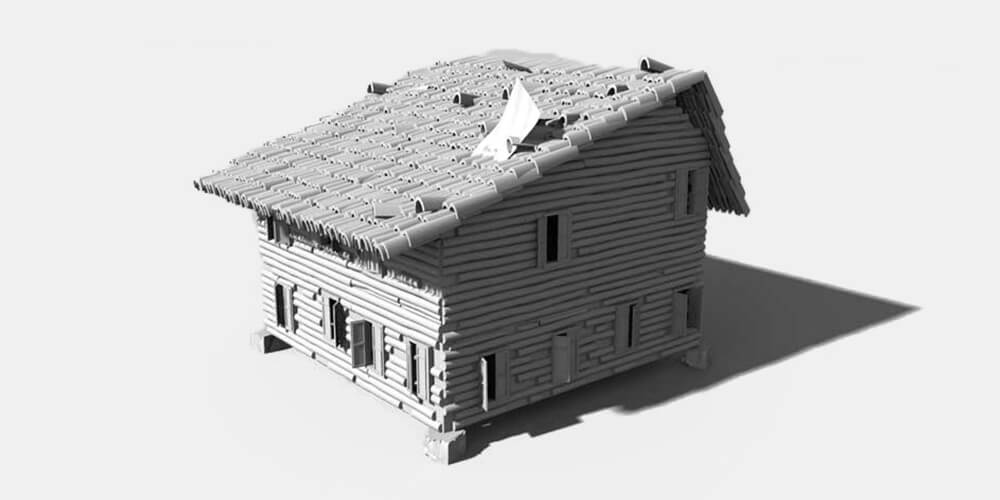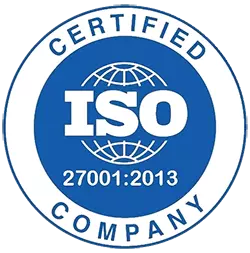13 Types of 3D Modeling Techniques to Choose in 2025

Various types of 3D modeling techniques have found widespread applications in diverse industries, thereby unlocking numerous design possibilities. In this article, we have discussed different types of 3D modeling techniques that are used to create 3D models for diverse purposes.
What is 3D Modeling?
3D modeling is the process of creating three-dimensional images or graphics to represent real objects and surfaces. The representation is usually done mathematically by manipulating the points in a virtual space. These points, technically known as vertices, are used to form a mesh, which gives the shape of an object.
Common Techniques Used in 3D Modeling
Generally 3D modeling techniques are used to create 3D models of different types or shapes of objects that are mathematically represented in three dimensions. The most commonly used 3D modelling techniques are box, NURBS, procedural, sub-division modeling, etc. Here we have listed the most commonly used techniques for diverse purposes.
-
Box modeling
 3D Box Modeling
3D Box ModelingIn the box modeling technique the artist uses a geometric shape, like a cube, cylinder or sphere, and shapes it until the intended appearance is achieved. The modelers carry out the process in different stages. They start with a low-resolution polygonal mesh and then refine the shape. Then they divide the mesh further, ensuring that the hard edges are smoothed out and the necessary details are added. They repeat the process of refining and subdividing till enough polygonal detail is present in the mesh, which can convey the desired concept. Box modeling is one of the most common polygonal 3D techniques and is used in combination with the edge modeling ones.
View this PPT to learn about the different types of 3D modeling techniques used to create high-quality 3D models with accurate details.
-
Contour/Edge modeling
 Edge Modeling
Edge ModelingEdge modeling is another type of polygonal technique, although it is different from the box technique. In this process, the modelers develop the model piece by piece instead of refining a primitive shape.
This is done by placing the loops of polygons along the outlines and filling the gaps that lie between them. This process is applied because it is difficult to complete certain meshes through the box modeling technique.
-
Spline/NURBS modeling
 Nurbs Modeling
Nurbs ModelingThis Nurbs modeling technique is extensively used in the industrial and automotive industries. A NURBS mesh does not have any edges, faces, or vertices. These models come with surfaces that can be interpreted smoothly. The modelers can develop the concept by lofting a mesh between the splines. The NURBS curve is developed using a tool similar to the pen tool used in Adobe Photoshop or MS Paint.
The modelers draw the curves in 3D space and edit them by moving the control vertices, which are a series of handles. The curves are to be placed along prominent contours, and the space between them is automatically interpolated by the 3D modeling programs. Alternatively, you can also create a NURBS curve using a profile curve, revolving it around a central axis. This is one of the most extensively used 3D model design techniques used to develop objects such as vases, wine glasses, and plates.
-
Subdivision modeling
 Subdivision Modeling
Subdivision ModelingSubdivision modeling is performed with a combination of polygonal and NURBS modeling techniques. In this hybrid process, a polygon model helps in creating 3D models, which are then converted into sub-division models. The artist enjoys control over the refinement of the 3D model in certain areas. Besides, you can use diverse software to work on these models. The polygon needs to be subdivided and refined until the details are clear. With greater subdivision, the surface becomes smoother.
-
Digital sculpting
 Digital sculpting
Digital sculptingThe tech industry has adopted various 3D modeling processes that they refer to as disruptive technologies. The experts use advanced 3D modeling software to develop these models. The automobile industry has also evolved, with these technologies finding applications in product development and marketing. Digital sculpting is a type of disruptive technology that has leveraged the 3D modeling process to a great extent. The modelers now need not carry out the painstaking constraints of edge flow and topography. This enables them to design different types of 3D models in a way similar to the process of sculpting digital clay.
Here, the meshes are organically created. A tablet device is used to shape the model, just like a sculptor uses a brush on chunks of clay. With digital sculpting, creature and character sculpting have reached new levels. The modelers can carry out the process much faster and with greater efficiency. The artists can work with high-resolution meshes containing millions of polygons.
Modular modeling
 3D Modular Modeling
3D Modular ModelingKeeping modularity in mind is a good idea when creating a 3D asset. While modeling multiple buildings that look similar, we should think about modularity. This modular modeling helps to interchange the components in the 3D model, which can even go as far as to model different sections of the building and help in rearranging them in different ways to create variation.
Kitbashing
 Model Bashing Technique
Model Bashing TechniqueKitbashing is used to detail an object made with different types of modeling.It is a type of modeling that starts with the object kit being combined into more detailed objects.
This technique is commonly used while creating objects with a hard surface and helps explore how different pieces could fit together even before the construction starts. This technique is an excellent way to detail a scene. Three things to keep in mind while using this technique are the ratio of high, mid, and low-frequency detail.
Photogrammetry
 Photogrammetry
PhotogrammetryPhotogrammetry is a completely different way of creating 3D models using a camera. By photographing an object multiple times from different angles in a perfect lighting condition and then feeding those images into a program that interprets them and generates a 3D object representation, we get real-world data, meaning whatever we create is close to realism. This technique is a relatively new invention that has gained a lot of traction. Using drones, we can photograph the whole area and recreate larger structures.
-
Procedural modeling

Procedural modeling refers to the 3D design process of generating models algorithmically. Unlike other processes, these are not created manually by the artist. In this process, objects and scenes are developed on the basis of user-defined parameters or rules. In various environment modeling packages, the modelers can create entire landscapes by modifying parameters like elevation range and foliage density. They can also choose from landscapes such as coastal areas, deserts, or alpine areas.
The procedural modeling technique is extensively used in organic objects such as foliage and trees, where the complexity and variations are more infinite. These models are extremely difficult to draw by hand. These objects can further be tweaked through various editable settings. For instance, you can change the density of branches, the height of tree trunks, and the curls and angles as per your needs.
-
Image-based modeling
 Image-based Modeling
Image-based ModelingIn image-based modeling, 3D objects are derived algorithmically from a set of 2D images that are static in nature. This type of technique is used in cases where the modeler faces budgetary or time restrictions and is not able to develop fully realized 3D images. This is one of the most commonly used techniques in the film industry. Over the years, image-based modeling has become increasingly popular in the entertainment industry.
Surface modeling

Surface modeling helps in creating a 3D spline. The process involves the incorporation of a 2D spline, and it is different from NURBS. This method is primarily used to generate organic 3D models in films. It offers a good amount of flexibility to the modelers. They can easily create a 3D representation with various requirements, using curves or surfaces.
-
Boolean modeling
 3D Boolean Modeling
3D Boolean ModelingIn this 3D modeling technique, the shape of an object is created with the help of two objects. The geometry is either created by combining two objects or cutting out one from the other. It can also be created with negative intersection space. Boolean modeling helps in creating 3D shapes that take time to create with other techniques. For example, bent and circular shapes can be combined with hard-surfaced or square ones to create a new shape. The technique is however not so popular in the entertainment industry.
-
Laser scanning
 3D Laser Scanning
3D Laser ScanningLaser scanning was introduced as a 3D modeling method due to the pronounced advancements of this technology. Here, a laser is used to scan a real life object and measure its geometry for creating a 3D model representation. The process is easy and quick, and it does not require physical touching of the objects to take the exact measurements. Once the measurements are taken, you can develop a digital model with the help of the 3D imaging software. However, you do need to clean up the geometry before you start using it.
Related Article : Top Fields to Specialize as a 3D Artist
To wrap it up…
Evidently, advanced 3D modeling techniques are being used in various industries, and companies are collaborating with reputed 3D model design service providers for dedicated support. In case you need expert 3D modeling services, reach out to us with your requirements.
Contact Us

